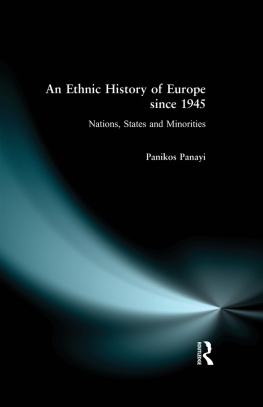This book made available by the Internet Archive.









MINORITIES, MIGRANTS, AND CRIME
INTRODUCTION
Ineke Haen Marshall
This book is the product of the enthusiastic collaboration of several authors living and working in the United States, Britain, Sweden, Germany, Italy, France, Belgium, the Netherlands, and Spain . 1 The objective of this book is to give some sort of general inventory of what is known about ethnic and racial minorities, noncitizens, foreigners, immigrants, and crimeincluding law enforcement priorities; punishment philosophy and practices; media coverage; and political, scholarly, and public discourse on these issuesin these European countries, as well as in the United States.
Does it make sense to bring the experiences of this wide variety of nations together? In spite of a growing sense of we-ness among European nations, national boundaries continue to reflect sharp differences in language, culture, history, and politics. Political, cultural, and legal variations between these European countries make most claims to comparability and generalizations about Europe open to challenge. Enter the United States into the picture, and the situation gets even more complicated. Internationally, the United States is a nation both envied and despised, admired and ridiculed.
X
MINORITIES, MIGRANTS, AND CRIME
The United States is one of the worlds superpowers: It has a leading economic, political, and, to the dismay of many, cultural role in the world. 2 The land of the great, home of the free also has one of the highest murder rates in the industrialized world, has more inmates in prison than almost any other Western society, still executes several offenders each year, and is at a loss regarding what to do about the large numbers of babies born to teenage girls, or how to resolve the structural unemployment problems of the decaying inner cities. It struggles with outbursts of racial violence; its citizens are increasingly polarized: the haves who hide themselves in distant well-kept suburbs, and the have nots living on the streets, or in poor housing in rural areas or inner cities. There is no doubt: The contrasts in the United States are much more extreme than those found in most Western European countries. In many ways, the cultural gap that separates the United States and Europe is more formidable than the mere 6,000 miles or so of Atlantic Ocean between the two continents (see, for example, Kroes, 1992).
How then do we make the connection between American experiences and Europe? A different, but related question is, How do we link race, ethnicity, migration, and citizenship issues? I will elaborate on this in the last chapter of the book, but for now let us pretend for a minute that it is possible to forget all we know about history; pretend that we descend from the planet Marsour assignment being to provide an overview of the diverse social groupings living in Europe and the United States. The astute Martian observer will note that some social groups have very little power to influence social, political, or economic events; members of these relatively powerless groups often are visibly different from the rest of society; they are stereotyped, and frequently discriminated against by the rest of society. The Martian observes such groups all over the world, including in the Netherlands, Germany, France, Belgium, and the United States. But the creature from outerspace is puzzled: Sometimes, concepts such as ethnicity or race are used when earthlings talk about these groupswhereas other times, it is citizenship, nationality, immigration status. Could it be that these terms are secret earthly codewords for something else? It does not take long before the visitor figures out that the key to it all really is quite straightforward; all these groups seem to have two things in common: (a) a marginal social position in society (in terms of employment, education, housing, political influence), and (b) a distinct ethnic-cultural position, characterized by prejudice and stereotyping, self-identification, and shared customs (cf. Penninx, 1994). Minority status is the thread that unites migrants, foreigners, indigenous ^ ethnic minorities, and nonnative resident ethnic groups; it is the minority
Introduction
XI
concept that reveals international parallels and similarities, sometimes overshadowing important national differences and local specificities; it is the minority perspective that builds a bridge between the United States and Europe. 3
Why do we start these chapters with this cultural outlier, this exceptional case of the United States? The reason is simple: The United States very complex immigrant heritage, together with its long and checkered race relations history, makes this society a uniquely valuable source of insight and experience with regard to the volatile mixture of race, ethnicity, nationality, and immigrant status. If we want to accomplish cross-fertilization of the different approaches to minority research and theory, whether it takes place under the conceptual umbrella of race studies, ethnicity studies, or immigration studies, we must be open to the possibility of shared experiences and commonalities between recent developments in Europe and the United States. Some have vehemently rejected such efforts as artificial, misguided, and useless. These arguments, however reasonable they might have appeared years ago, are less and less convincing in the 1990s. We know so much more now than we did even 10 years ago. We know more about migrants and ethnic minorities, more about the push and pull factors of migration, more about criminalityin both Europe and the United States. We know more about the socio-political-economic dynamics of world change. There is no doubt that scholars on both continents have come a long way since the early beginnings of research and theory on migration, race, ethnicity and crime (Bonger, 1943; Ferracuti, 1968; Sellin, 1938). Not only has our knowledge grown tremendously, there also have been substantial changes in (type and motivation of) migrants, host countries, as well as in global context (cf. Schmid, 1996; Sun & Reed, 1995) over the last decadechanges that are shared by many of the European countries. Changes that make the leap across the Atlantic Ocean less formidable than ever before.




























